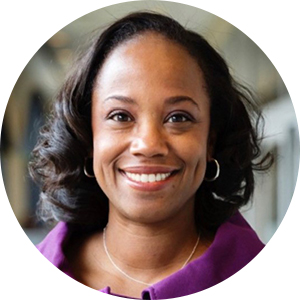Women’s health Q&A with 5 women health care executives
Health care is shifting its approach to women’s health*. Who better to explain what’s driving that change than women executives working in the industry.

In an effort to create a more equitable and inclusive workplace, a growing number of employers are reshaping their health benefits. Specifically, offering comprehensive women's health benefits has become critical to retaining and attracting top talent.
To best meet the needs of their employees, employers should ensure their health benefits strategy supports all stages of a woman’s life — including those of their dependents or children. These stages include:
- Adolescence and young adulthood – Providing employees with resources to help them navigate the changing health and well-being needs that their children may experience during their adolescent and young adult years
- Adult health and wellness – Offering benefits that aim to address the conditions and health issues that tend to affect adult women uniquely, differently or disproportionately
- Family building – Providing coverage and benefits that aim to help support women who are seeking to expand their families
- Peri- through post-menopause – Offering solutions and benefits that aim to support women as they experience the various symptoms and stages of menopause, from peri- through post-menopause
Fortunately, many employers have recognized the importance of this and are taking action. In fact, a recent survey found that 46% of employers provide at least 1 specialized benefit or resource to support women’s health, which could include benefits for everything from pre-conception family planning to menopause — up from 37% in 2023.1
Although research shows there is still progress to be made in ensuring women receive the necessary care, there are some promising signs that the health care industry is moving in the right direction.2 For instance, commercials and ads for medications that treat menopause symptoms and postpartum depression have become more common, in addition to increased funding and research around women’s health.
To better understand this evolution, what’s driving it and how employers can meet the expectations of today’s workforce, UnitedHealthcare turned to a panel of 5 women executives who share a combined 125 years of health care experience to answer the following questions:
- Why are you passionate about women’s health?
- Why should employers care about supporting women across all life stages
- What’s driving the growing interest in women’s health?
- What’s most important for employers to consider to better support women’s health needs?
- What role does UnitedHealthcare have in advancing women’s health?
- What’s next for women’s health?
*“Women’s health” is a broader term used to describe conditions, services or supportive programs and resources, not to describe those supported. UnitedHealthcare provides supportive resources for all eligible individuals, regardless of gender identity.

Stephanie Fehr, SPHR
Chief People Officer, UnitedHealthcare

Dr. Lisa Saul, MD., MBA
National Medical Director/Chief Medical Officer, Women’s Health, UnitedHealthcare

Dr. Rhonda Randall, DO
Chief Medical Officer, UnitedHealthcare Employer & Individual

Kara Marlatt, Ph. D., MPH
Expert Partner, Advisory Board

Nancy Blase, MBA, BSN, RN
Sr. Director, National Commercial Product & Innovation, UnitedHealthcare Employer & Individual
Why are you passionate about women’s health?
Fehr: I first started talking about women’s health, because, personally, I didn’t feel I was supported adequately as a woman, and that I had enough information about what it would be like as I progressed through different life stages. For instance, right around the time that I became chief human resource officer for UnitedHealthcare, I started experiencing menopause symptoms: lack of sleep, hot flashes and brain fog. This was a real challenge as I navigated a demanding new position — and a topic I wasn’t comfortable openly talking about with my colleagues. As a mother of 2 daughters, I’m passionate about making sure they are equipped with the data, resources and support they need to successfully navigate from adolescence through menopause.
Dr. Saul: Women’s health care has traditionally been very episodic in nature and lacking continuity as women journey from adolescent health through post-menopausal health. As an example, I’m having conversations with my teenage daughter who is an athlete. I’m teaching her how take care of her health, including how to fuel her body and maintain her well-being. I’m prepping her for the future as well, explaining how choices today can impact her health later in life. Those dots aren’t always connected when employers see women’s health as beginning and ending with maternity support. We’re making strides, but we still have a long way to go before conversations about the full spectrum of women’s health care are as commonplace as conversations about hypertension and diabetes, for instance.
Why should employers care about supporting women across all life stages?
Dr. Saul: Supporting women’s health is critical because women make up a large portion of today’s workforce and that workforce spans multiple generations. Working women wear multiple hats, such as partner, mother, primary caregiver, financial contributor and are also often the main decision-maker for their family. This is why it’s so important for them to get the support they need, when they need it. Because if they aren’t being cared for, there’s likely to be a domino effect that can impact the rest of their family and even their colleagues. We need to be able to put the oxygen mask on ourselves before we’re able to help others around us.
Dr. Randall: If women aren’t able to access the information or support they need to manage a health crisis for themselves or a family member through their employer-sponsored health plan, absenteeism, presenteeism and a drop in work productivity can be the result. Conversely, a woman who feels supported by their employer throughout the different life stages both they and their families experience is going to be more likely to stay with or choose that employer. All that to say, supporting women’s health should matter to employers, because it can help them attract and retain top talent.
Marlatt: There are many instances where women who are at the height of their careers decide to turn down advancement opportunities or even leave the workplace, due to the difficulties they were facing during their midlife years. That’s one example of the impact not supporting women’s health can have. Fortunately, more employers are realizing that there is a big ROI when they dedicate resources to supporting the health of women. In making the case for funding women’s health research, one analysis estimated that an investment of $300 million in women’s health research across just 3 diseases — Alzheimer’s disease, coronary artery disease and rheumatoid arthritis — would result in $13B in returns to our economy.3 Beyond that, we see an improved quality of life, higher overall productivity and better health outcomes at lower costs.
What’s driving the growing interest in women’s health care?
Blase: Women are developing a stronger voice in the U.S. With that voice comes increased recognition and a sense of empowerment to advocate for the health benefits and services they need to care for themselves and their families. In many cases, they have become the main breadwinners for their families, so they need to ensure they are their healthiest and most engaged selves as they enter the workplace. They understand that, if they can’t get their health issues resolved quickly and thoroughly, they can’t be present and productive at work. Employers are starting to understand this as well, and I believe over the next 3 to 5 years we’ll see more employers making women’s health a real priority.
Dr. Randall: Many women are in the boardroom now. They are increasingly not only the main decision-makers for their families, but also for the companies they work for. Those same women are hungry to have conversations about women’s health that haven’t been had before. The result is that it’s becoming more and more common for employers to ask us to speak to them and their workforces about women’s health. In my 20+ years in the health care industry, we were almost always limited to speaking about women’s health in relation to their reproductive years. Now, the conversation is broadening to include adolescent health, fertility and maternity, menopause — in other words, supporting women through all stages of their lives.
Marlatt: FemTech companies exploded during the pandemic to help address gaps in women’s health care.4 For instance, while OBGYN offices tend to have endless resources about pregnancy and pregnancy-related conditions, not as many offer resources for midlife events like post-pregnancy and menopause. Those are some of the gaps FemTech companies are trying to solve for. It’s encouraging because we seem to be experiencing a paradigm shift. For example, for the first time, I’m seeing commercials and ads for medications and care solutions specific to menopause — an indication to me that society is finally breaking through the taboo that’s traditionally surrounded women’s health.
What’s most important for employers to consider to support women’s health needs?
Fehr: No one disputes that women’s health is an area in need of attention. What employers have to decide is what to prioritize and where to make the right investments. That starts with listening to their workforce and analyzing claims data from that population. Are there a lot of women employees utilizing maternity benefits? What percentage of the population is seeking support for menopause? Are there a lot of parents seeking mental health support for their daughters’ adolescent health? Knowing the answers to these questions can help employers make those decisions and determine their women’s health plan strategy.
Dr. Randall: Employers with younger workforces should consider how they are supporting their employees’ family forming health needs. A high-risk pregnancy can be a difficult time for a woman. It can increase the chance for gestational-related conditions like gestational diabetes and preeclampsia. Pre-existing, underlying health conditions like hypertension can be aggravated during pregnancy too and have ripple effects for a woman’s long-term health. Behavioral health is another area that needs to be addressed, as women are disproportionally affected by mental illness. Ensuring they have access to behavioral health care resources is important for them to be able to manage their mental health, especially for issues like postpartum depression.
What role does UnitedHealthcare have in advancing women’s health?
Blase: I think all carriers recognize the growing demand for a more comprehensive and whole-person approach to women’s health. UnitedHealthcare is uniquely positioned to lead the charge and dig the deepest in this space, in part due to the enormous amounts of data we’re able to collect, access and analyze to understand utilization trends. We also have the ability to collaborate across our entire enterprise and tap into experts with diverse backgrounds from many different sectors. Our collaboration with Maven as an industry leader in the women’s health space is a great example of that. Through Maven, our members have access to on-demand support related to any life stage they may be going through, including support spanning fertility, pregnancy, adoption, parenting, pediatrics and more.
Dr. Saul: UnitedHealthcare has a significant role to play in the women’s health space, including supporting employer efforts around educating women about the benefits available to them. Working with employers to develop communications for different segments of their employee population is critical, and we need to continue to evolve how we make that information more accessible to employees. In addition, by working with providers to support the care they provide, we can reach members on multiple fronts.
Dr. Randall: UnitedHealthcare not only has access to our member claims data, we also invest in third-party research that is unmatched by other carriers. We understand that this insight can lead the conversation to advancing women’s health. Another area we are working on is to simplify administrative processes and deliver a more consumer-centric health care experience. Members want one place to go for their benefit information. UnitedHealthcare continues to invest heavily in our digital platforms to simplify and personalize the digital experience for our members — giving them one place to access and view recommended benefits and solutions based on their unique health needs. We also recently launched the UHC HubTM, which is a curated network of vendors that complement our existing solutions and make it easier for employers and employees to access a variety of solutions and services, including within the women’s health space.
What’s next for women’s health?
Fehr: As an HR executive, it’s important for employers to better understand the full health care journey of their women employees. Because, once they understand what support is needed at every step of that journey, they will be better equipped to design a health benefits strategy that supports those employees and helps guide them on a path to better health.
Marlatt: We’re seeing a lot of discussion about investments in new technologies that address women’s health, particularly wearables. That has the potential to make women’s health care more personalized, effective and easy to use. Also, finding ways to break through the barriers that may prevent employers from supporting women, and specifically women in midlife, is critical. And this should matter to employers, because untreated menopause symptoms, for example, is estimated to cost U.S. employers around $1.8 billion annually in missed workdays alone.5
Dr. Randall: I’m seeing that newer startup companies, particularly those that are women-owned, are changing the dynamics in terms of what the workforce in general is going to expect regarding leave – whether it’s expanded maternity leave, sabbaticals or even increased paid time off. We’re also seeing an appetite for a greater expansion of benefits beyond infertility coverage, but employers will need to find the right balance, particularly in industries with high turnover or workforces that lack stability. Early access to care is also extremely important. Carriers who collaborate with employers, health care professionals and communities to encourage preventive care — build trust. Part of that conversation includes addressing health equity as well as social drivers of health which may present barriers to care.